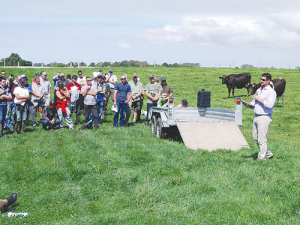Australian teams to help repair North Canterbury irrigators after storm
Moves are afoot to get a team of Australians over here to help repair North Canterbury's irrigation machinery, ravaged by the big windstorm of late October.
 IrrigationNZ project manager Steve Breneger speaking at a Lincoln University dairy farm field day earlier this year.
IrrigationNZ project manager Steve Breneger speaking at a Lincoln University dairy farm field day earlier this year.
A summer-long on-farm study of irrigation efficiency in the Ashburton area will provide a benchmark for progress.
This is the message from study leader, IrrigationNZ project manager, Steve Breneger.
In partnership with Environment Canterbury, INZ employed post-graduate environmental science students to collect data for four months, looking at how farmers were operating equipment, applying water, scheduling maintenance and monitoring soil moisture and run-off.
Breneger says the data showed that most farmers were operating within limits and were genuinely focussed on finding efficiencies. “We discovered that most of the systems tested were within tolerance levels and over half of the respondents were doing some form of scheduling. On farms that weren’t meeting efficiency targets, the students then looked at [possible causes].
“The value we gained was that not only did we have actual data from bucket testing, we also had insight from the students: they were able to add context and experience to gain a broader picture of what was really happening on-farm. Where they discovered discrepancy between what the farmer thought he was applying versus what he was actually applying, they were able to look at operational and maintenance factors as possible contributors.”
Breneger says he believes it is the most complete data set yet gathered on on-farm efficiency.
“The reason I got involved was that even at Irrigation NZ we only have anecdotal data. We can say ‘we think 20% of farmers may have a significant issue with their irrigation’. I now know that number.”
The students tested 244 systems on 131 farms -- dairy, sheep and beef, deer and arable. They tested centre pivots, laterals, travelling irrigators, hard hose guns and sprayline systems.
Of the systems tested, 52% achieved good to excellent distribution uniformity (DU); 32% fair DU and 16% poor DU. Possible contributors to poor DU were identified as worn components, sediments in water supply and incorrect hardware.
On target application depth, 37% were within 10% of the target depth; 31% were within 25%, and 32% were outside the target by at least 25%. Contributing to poor results were incorrect set-up and commissioning during installation (including components), poor understanding of the system’s constraints, poor maintenance and technology failures.
Breneger says the survey succeeded because it included practical advice on fixing the shortcomings, promoting “good engagement” with the farmers.
“We went out and tested their farms then gave the farmers a report on their systems. And they had opportunity to sit down with me and the students and talk one-on-one about their results: where the issues are and what they can do to overcome them.”
The programme showed each farmer must understand his system and maintain it regularly.
“One farmer’s DU and application depth showed poor results after the initial bucket testing. He discovered the operating pressure wasn’t high enough so he replaced the regulators on his pivot and got the service company to check the programmable set-up and correct any errors. After re-testing, he’d turned his ‘poor’ result around, achieving 99% of the target depth and overall DU of 0.85, which is considered excellent.”
Final results of the study were unveiled at INZ’s Great Irrigation Challenge workshop in Ashburton in late May.
Breneger had earlier presented interim results of the study at an LUDF focus day in late February, when he said 50% of irrigating farmers surveyed needed to “lift their game” in some respect. He said 25% of farmers only did the regulatory checks “when they have to”, and 43% did not know either of the two key performance indicators of their system – pressure and flow.
Effective from 1 January 2026, there will be three new grower directors on the board of the Foundation for Arable Research (FAR).
The National Wild Goat Hunting Competition has removed 33,418 wild goats over the past three years.
New Zealand needs a new healthcare model to address rising rates of obesity in rural communities, with the current system leaving many patients unable to access effective treatment or long-term support, warn GPs.
Southland farmers are being urged to put safety first, following a spike in tip offs about risky handling of wind-damaged trees
Third-generation Ashburton dairy farmers TJ and Mark Stewart are no strangers to adapting and evolving.
When American retail giant Cosco came to audit Open Country Dairy’s new butter plant at the Waharoa site and give the green light to supply their American stores, they allowed themselves a week for the exercise.
President Donald Trump’s decision to impose tariffs on imports into the US is doing good things for global trade, according…
Seen a giant cheese roll rolling along Southland’s roads?